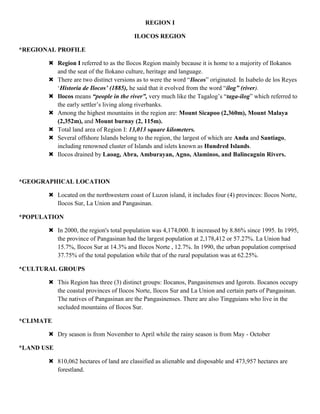Region 1 - (ilocos region)
- 1. REGION I ILOCOS REGION *REGIONAL PROFILE ï Region I referred to as the Ilocos Region mainly because it is home to a majority of Ilokanos and the seat of the Ilokano culture, heritage and language. ï There are two distinct versions as to were the word âIlocosâ originated. In Isabelo de los Reyes âHistoria de Ilocosâ (1885), he said that it evolved from the word âilogâ (river). ï Ilocos means âpeople in the riverâ, very much like the Tagalogâs âtaga-ilogâ which referred to the early settlerâs living along riverbanks. ï Among the highest mountains in the region are: Mount Sicapoo (2,360m), Mount Malaya (2,352m), and Mount burnay (2, 115m). ï Total land area of Region I: 13,013 square kilometers. ï Several offshore Islands belong to the region, the largest of which are Anda and Santiago, including renowned cluster of Islands and islets known as Hundred Islands. ï Ilocos drained by Laoag, Abra, Amburayan, Agno, Alaminos, and Balincaguin Rivers. *GEOGRAPHICAL LOCATION ï Located on the northwestern coast of Luzon island, it includes four (4) provinces: Ilocos Norte, Ilocos Sur, La Union and Pangasinan. *POPULATION ï In 2000, the region's total population was 4,174,000. It increased by 8.86% since 1995. In 1995, the province of Pangasinan had the largest population at 2,178,412 or 57.27%. La Union had 15.7%, Ilocos Sur at 14.3% and Ilocos Norte , 12.7%. In 1990, the urban population comprised 37.75% of the total population while that of the rural population was at 62.25%. *CULTURAL GROUPS ï This Region has three (3) distinct groups: Ilocanos, Pangasinenses and Igorots. Ilocanos occupy the coastal provinces of Ilocos Norte, Ilocos Sur and La Union and certain parts of Pangasinan. The natives of Pangasinan are the Pangasinenses. There are also Tingguians who live in the secluded mountains of Ilocos Sur. *CLIMATE ï Dry season is from November to April while the rainy season is from May - October *LAND USE ï 810,062 hectares of land are classified as alienable and disposable and 473,957 hectares are forestland.
- 2. *NATURAL RESOURCES ï The region is a producer of food surplus - rice, corn, vegetables, root crops and fruits such as mangoes. *ECONOMY ï As part of the Northwestern Luzon Growth Quadrangle (NWLGQ) and Northern Luzon-South China growth area, it has good potential for export-oriented agri-industrial development and tourism activities. *URBAN CENTERS ï Laoag City in Ilocos Norte, Vigan in Ilocos Sur, San Fernando in La Union and the capital town of Lingayen and the cities of Dagupan and San Carlos in Pangasinan are the centers of trade, business, and education. *FACILITIES ï The region has fairly a developed intra-regional and inter-regional road network. Approximately 99% of all municipalities or 96% of all barangays have access to electricity. Private and government telecommunication services area available in most areas of the region especially in urban centers. *POLITICAL DIVISIONS ï Region I is composed of 4 provinces, 9 cities, 116 municipalities, and 3265 barangays. *FESTIVALS IN REGION ï Vigan city fiesta ï Viva Vigan Festival of the Arts ï World Heritage Cities Solidarity Day ï Lingayen Gulf Landing ï Laoag City and Province (Pamulinawen) ï San Fernando, La Union ï Gali-la Hundred Island festival ï Agoo Semana Santa ï Cutud Lenten Rites ï Pistaây Dayat (may 1)
- 3. *NATIONAL PARKS ï Hundred Island National Park ï Paoay Lake National Park *NATURAL WONDERS AND MANMADE WONDERS ï BANGRINE MARINE PROTECTED AREA ï VILLACORTA/BITMATYA/CACUPANGAN CAVES ï LA UNION BOTANICAL GARDEN ï LA UNION SURFING ï PAGUDPUD ADVENTURE ï VIGAN HERITAGE VILLAGE ï KAPURPURAWAN ROCK ï CAANGRIAN FALLS ï BALINGASAY RIVER ï TUDDINGAN FALLS ï LON-OY SPRING ï TREKKING ADAMS *CULTURE AND TRADITIONS ï Ilocanos are the ruling ethinicity in Region 1. They constitute the majority of the population in the Ilocos region particularly in Ilocos Norte (97%), Ilocos Sur (97%), La Union (92%), and Pangasinan (45%). Minority groups include Tingguan and Isneg communities who inhabit the foothills of the Cordillera Mountains. *FAMILY ï The structure of the Ilocano family conforms to the general Filipino pattern. Most families compose of an average size (6-7 persons). *CLOTHING ï Ilocanos are very meticulous when it comes to clothing. They dress up according to their age and perceived wealth. Everyday wear consists of short pants for boys, and dusters, loose skirts, shirts, and short pants for girls. Farmers wear long-sleeved shirts, long pants, and wide-brimmed hats.
- 4. *WEDDING TRADITION ï The groom makes a panagpudno (formal announcement) to the soon-to-be brideâs parents about his intention of marrying their daughter. His parents will then visit the brideâs parents to set the wedding date. Usually, parents consult a planetario, which is like an almanac that identifies âluckyâ days. *DEATH TRADITION ï To announce a death of a family member, a piece of atong wood is lit in front of the deceasedâs house. It is kept burning until after the burial. The fire is extinguished with white wine.




